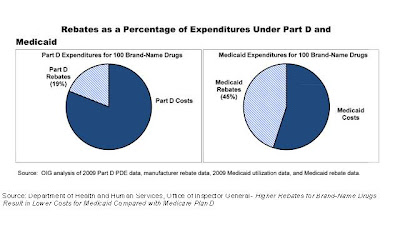Click image to enlarge. Source
There’s been a lot of tooth-gnashing lately about how Medicaid pays substantially less than Medicare to acquire prescription drugs. For instance, the graph above is currently on the front page of the New England Journal of Medicine’s Health Policy and Reform website, and shows Medicaid rebates over twice as high as Medicare rebates
It’s worth going back to the law that granted Medicaid its non-negotiated mandatory high rebates – the Omnibus Budget Reconciliation Act of 1990 (OBRA 1990 for short). OBRA is part of a long and proud history of passing important health legislation through the reconciliation process, which includes the Patient Protection and Affordable Care Act (2010) and the Consolidated Omnibus Reconciliation Act of 1986, which we all know as COBRA, – which allows departing workers to purchase health insurance for 18 months.
OBRA 1990 is probably most famous for George HW Bush’s breech of his 1988 election promise, “Read my lips; no new taxes!” OBRA 1990 raised the ceiling on income for Medicare tax and extended taxes on gasoline and telephone service. Conservatives were pretty angry. It also implemented PAYGO, whereby legislators passing spending bills would have to identify a source of revenue.
OBRA also allowed states to establish drug utilization review panels, and mandated that pharmaceutical companies offer a substantial rebate to state Medicaid programs for brand name drugs that were on each state’s preferred drug list. That rebate would effectively allow the Medicaid program to get the “most favored” pricing. Therefore, if the pharmaceutical company offered a deeper discount to any purchaser, its rebate to states would be increased.
You might have thought that would be a terrible blow to the pharmaceutical companies – forced against their will to offer big discounts without the ability to negotiate. But that’s not how this played out. The mandate that Medicaid would get the lowest prices (without needing to negotiate) actually made the pharmas dramatically less likely to offer discounts to others, and indeed the Congressional Budget Office
found that discounts to other purchasers declined dramatically after the ‘most favored’ pricing for Medicaid became effective. That’s because the threat of having to offer large rebates to over 50 different state Medicaid agencies helped enforce pharmaceutical pricing discipline – and thus raised the overall acquisition cost for pharmaceutical agents.
I first learned about this in Coopetition (Brandenberg and Nalebuff, 1996)
Click to enlarge. Source
There is one more chapter to this saga. Some of the sickest and neediest patients are dually eligible for both Medicare and Medicaid. They are often either completely disabled, severely mentally ill, or residents of nursing home. Medicaid paid for all ambulatory medicines for these patients until the introduction of the Medicare prescription drug plan in 2003 – and Medicaid paid with this “most favored” pricing. Medicare Part D, however, forced these patients to enroll in privately-run Medicare Part D pharmacy programs, which were not able to have the same low acquisition costs.
This was great for the states, which liked the federal government picking up the entire tab for prescriptions for this sick population; states had previously paid half. It was perfectly fine for the Medicare Part D plans, which gained more premium revenue. It was especially fine for the pharmaceutical companies, since they were able to obtain higher prices for a population that used a lot of prescription drugs. It wasn’t so great for patients, who often had difficulty navigating the confusing world of Medicare Part D plans.
Back to today – there are calls for the pharmaceutical companies to offer higher rebates to Medicare Part D plans. I can’t say that mandating such rebates would be a windfall to the pharmas like OBRA 1990. But I can say that mandating rebates for some parties while maintaining negotiated prices for others distorts a market. We should be careful to “game out” the likely implications of higher mandatory rebates. A hybrid system with some prices controlled and others unregulated is likely to lead to higher prices for at least some of those getting prescription medications.
 6:23 PM
6:23 PM
 indigo
indigo



